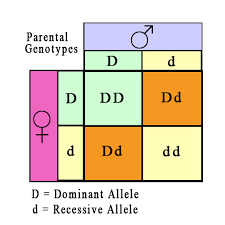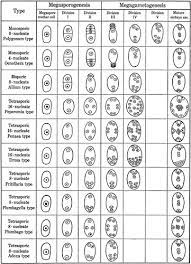FERTILIZATION
FERTILIZATION
POLLEN TUBE
GROWTH:
The microspore is the first cell of the male gametophyte and is haploid. The development of male gametophyte takes place while they are still in the microsporangium. The nucleus of the microspore divides mitotically to form a vegetative and a generative nucleus. A wall is laid around the generative nucleus resulting in the formation of two unequal cells, a large irregular nucleus bearing with abundant food reserve called vegetative cell and a small generative cell. Generally at this 2 celled stage, the pollens are liberated from the anther. In some plants the generative cell again undergoes a division to form two male gametes. The pollen is liberated at this 3 celled stage. In 60% of the angiosperms pollen is liberated in 2 celled stage. Further, the growth of the male gametophyte occurs only if the pollen reaches the right stigma. The pollen on reaching the stigma absorbs moisture and swells. The intine grows as pollen tube through the germ pore. In case the pollen is liberated at 2 celled stage the generative cell divides in the pollen into 2 male cells (sperms) after reaching the stigma or in the pollen tube before reaching the embryo sac.
EMBRYOSAC:
The
functional megaspore is the first cell of the embryo sac or female gametophyte.
The megaspore elongates along micropylar- chalazal axis. The nucleus undergoes
a mitotic division. Wall formation does not follow the nuclear division. A
large central vacuole now appears between the two daughter nuclei. The vacuole expands
and pushes the nuclei towards the opposite poles of the embryo sac. Both the nuclei
divide twice mitotically, forming four nuclei at each pole. At this stage all
the eight nuclei are present in a common cytoplasm (free nuclear division).
After the last nuclear division the cell undergoes appreciable elongation, assuming
a sac-like appearance. This is followed by cellular organization of the embryo
sac. Of the four nuclei at the micropylar end of the embryo sac, three organize
into an egg apparatus, the fourth one is left free in the cytoplasm of the central
cell as the upper polar nucleus. Three nuclei of the chalazal end form three
antipodal cells whereas the fourth one functions as the lower polar nucleus.
Depending on the plant the 2 polar nuclei may remain free or may fuse to form a
secondary nucleus (central cell). The egg apparatus is made up of a central egg
cell and two synergids, one on each side of the egg cell. Synergids secrete
chemotropic substances that help to attract the pollen tube. The special
cellular thickening called filiform apparatus of synergids help in the
absorption, conduction of nutrients from the nucellus to embryo sac. It also
guides the pollen tube into the egg. Thus, a 7 celled embryo sac with 8 nuclei
is formed.
ENTRY OF
POLLEN TUBE INTO THE OVULE:
There are
three types of pollen tube entry into the ovule.
Porogamy:
when the pollen tube enters through the micropyle.
Chalazogamy:
when the pollen tube enters through the chalaza.
Mesogamy: when the pollen tube enters through the integument.
ENTRY OF
POLLEN TUBE INTO EMBRYO SAC:
Irrespective
of the place of entry of pollen tube into ovule, it enters the embryo sac at
the micropylar end. The pollen enters into embryo sac directly into one of the
synergids. The growth of pollen tube towards the ovary, ovule and embryo sac is
due to the presence of chemotropic substances. The pollen tube after travelling
the whole length of the style enters into the ovary locule where it is guided
towards the micropyle of the ovule by a structure called obturator (See Do you
know). After reaching the embryo sac, a pore is formed in pollen tube wall at its
apex or just behind the apex. The content of the pollen tube (two male gametes,
vegetative nucleus and cytoplasm) are discharged into the synergids into which
pollen tube enters. The pollen tube does not grow beyond it, in the embryo sac.
The tube nucleus disorganizes.
FERTILIZATION
(FUSION OF GAMETES):
The fusion
of male and female gamete is called fertilization. Double fertilization is seen
in angiosperms.
EVENTS OF
FERTILIZATION:
The stages
involved in double fertilization are:-
germination of pollen to form pollen tube in
the stigma;
growth of pollen tube in the style;
direction
of pollen tube towards the micropyle of the ovule;
entry of the pollen tube into one of the
synergids of the embryo sac,
discharge
of male gametes;
syngamy and triple fusion.
The events from pollen deposition on the stigma to the entry of
pollen tube in to the ovule is called pollen pistil interaction. It is a
dynamic process which involves recognition of pollen and to promote or inhibit
its germination and growth.
POLLEN GREMINATION:
In nature,
a variety of pollens fall on the receptive stigma, but all of them do not
germinate and bring out fertilization. The receptive surface of the stigma
receives the pollen. If the pollen is compatible with the stigma it germinates
to form a tube. This is facilitated by the stigmatic fluid in wet stigma and
pellicle in dry stigma. These two also decide the incompatibility and compatibility
of the pollen through recognition rejection protein reaction between the pollen
and stigma surface. Sexual incompatibility may exist between different species
(interspecific) or between members of the same species (intraspecific).The
latter is called self incompatibility. The first visible change in the pollen,
soon after it lands on stigma is hydration. The pollen wall proteins are
released from the surface. During the germination of pollen its entire content
moves into the pollen tube. The growth is restricted to the tip of the tube and
all the cytoplasmic contents move to the tip region. The remaining part of the
pollen tube is occupied by a vacuole which is cut off from the tip by callose
plug. The extreme tip of pollen tube appears hemispherical and transparent when
viewed through the microscope. This is called cap block. As soon as the cap
block disappear the growth of the pollen tube stops.
THE EMBROLOGY OF ANGISPERMS 6th EDITION Author; SS BHOJWANI, SP BHATNAGAR ,PK DANTU.





Comments